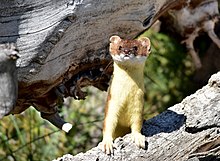
Back Neogale Catalan Neogale German Neogale FRR Wezelingen fan de Nije Wrâld Frisian Neogale Hungarian Neogale Italian Neogale Dutch Neogale Polish Neogale Portuguese Neogale Russian
| Neogale | |
|---|---|

| |
| Long-tailed weasel (N. frenata) | |

| |
| American mink (N. vison) | |
| Scientific classification | |
| Domain: | Eukaryota |
| Kingdom: | Animalia |
| Phylum: | Chordata |
| Class: | Mammalia |
| Order: | Carnivora |
| Family: | Mustelidae |
| Subfamily: | Mustelinae |
| Genus: | Neogale Gray, 1865 |
| Type species | |
| Mustela frenata[1] | |
| Species | |
| Synonyms | |
Neogale (colloquially referred to as the New World weasels) is a genus of carnivorous, highly active small mammals belonging to the Mustelidae family (which also contains badgers, weasels, martens, otters, and wolverines, among others). Neogale contains four species: the Amazon weasel (Neogale africana), the long and short-tailed weasels (N. frenata and N. lontra), and the American mink (N. vison). Native to the Americas, members of the genus can be found as far north as Alaska and as far south as Argentina and Bolivia. Across this distribution, they thrive in a range of habitats, from the deep-freezes of the Alaskan and Canadian boreal forests to the arid desert southwest, and from the humid tropics of Central and South America (including the Amazon basin) to the windswept foothills of the Andes and northern Patagonia.
- ^ Patterson, Bruce D.; Ramírez-Chaves, Héctor E.; Vilela, Júlio F.; Soares, André E. R.; Grewe, Felix (2021). "On the nomenclature of the American clade of weasels (Carnivora: Mustelidae)". Journal of Animal Diversity. 3 (2): 1–8. doi:10.52547/JAD.2021.3.2.1. ISSN 2676-685X. S2CID 236299740.